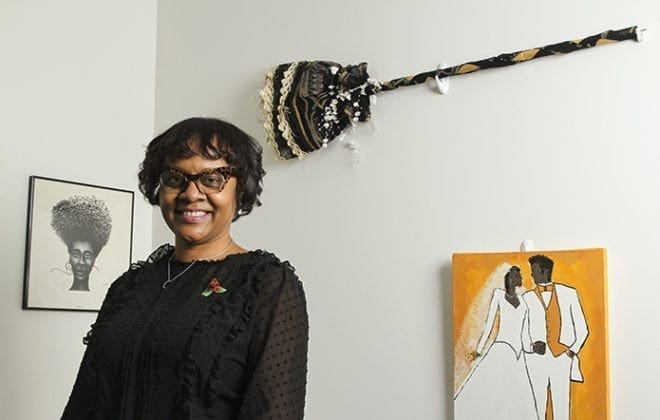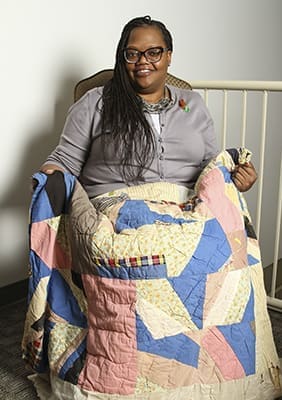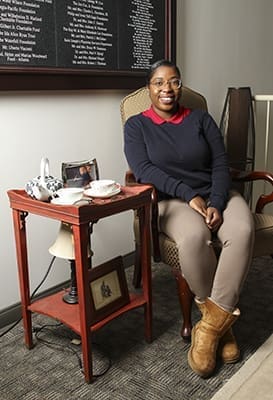Atlanta
Mercy Care exhibit highlights Black History Month
By ANDREW NELSON, Staff Writer | Published February 20, 2019
ATLANTA—Treasured family heirlooms, hand-sketched drawings done by a person living under a bridge and photos of a street protest calling for justice were some pieces for Black History Month featured at an exhibit at the Mercy Care offices on Decatur Street in Atlanta.
With these prized keepsakes, some 20 African-American staff members of the medical nonprofit shared their own history. The value of these items will not be found in a history book, but instead only from a place at a kitchen table where family histories were shared in memories and laughter.
Here, are some of the stories shared by three staffers of Mercy Care, a program that provides healthcare to people who are underinsured and people without insurance, including the homeless.
Patricia Parsons, Manager of Infectious Disease Services

Pat Parsons
Manager, Infectious Disease Services
Patricia Parsons was preparing to marry in October 2001 on the beach in Hilton Head Island, South Carolina. A girlfriend gave her a broom, decorated with different patterns of cloth that remind her of her African heritage. After the ceremony Parsons joined her new husband to jump over the broom, a custom at some black weddings. It made a statement for her.
“It is just like, Wow, this is feeling like I am going back in history, reliving what my ancestors did many years ago, in the 1800s. When slavery was going on, we could not wed our significant others. It was illegal for us to wed. This was significant thing for us to do, it’s a spiritual thing,” she said. “It gave us the opportunity to say ‘this is my husband, or this is my wife, and we are going to do this together, we are going to commit to one another, we are going to jump over this, jump over the broom and make that happen.’”
Now the broom hangs proudly on a wall in her home.
Kenya Arnold, Social Services Manager

Kenya Arnold
Social Services Manager
“I’ve had the quilt for about 12 years. It’s a fourth-generation keepsake. It’s kind of been passed down. I received it from my great-grandmother. When she passed away, it was entrusted to me. She received it from her mother,” said Kenya Arnold.
“It really made me feel proud and excited. It is really something that is a part of history, our own little part of history. Because I did not know my great-great grandmother, it makes me feel proud that she had it and she touched it and it warmed her and it kept her. It is from the late 1800s, early 1900s. She took care of it. It is really an extension of her that’s still here for me.”
Arnold keeps the quilt in a clear plastic bag. It isn’t used or washed. Dryer sheets are put in the bag every now and again.
“That’s just how I preserve it to keep it nice so I can pass it down,” she said.
Terrica Walker, Linkage to Care Specialist Lead, HIV testing and education
Terrica Walker recalled a conversation with her grandfather about her keepsake on display at Mercy Care and how she came to care for it:
“Granddad, can I get that piece that’s up in the attic?
And he was like, what piece are you talking about?

Terrica Walker
Linkage to Care Specialist Lead
And I was like, it’s a table.
No, don’t touch it.
You didn’t even know what I was talking about?
That’s been in our family longer than anything inside this house. That was my grandma’s. OK, I guess you can take it.
And when he gave it to me, I was pretty happy about that
It’s a table, he said it’s his grandma’s, so I am going to make sure I take good care of it.”
Walker’s great-great grandmother’s name is Bertha Smith and the table belonged to her. She was born in 1901 in Jasper County, Covington, Georgia, and died in 1980. The table had been in the attic for years until Walker took it down recently.
“I have now been going on a journey to compile and make a family tree and just learn more about family history,” said Walker. “At first it was just to fill up space, but then I started to thinking about, it is part of my black history so why not put it on display. It may not be a piece of art, or a picture or a painting, but it is history that was put into my family.”
-Photos by Michael Alexander